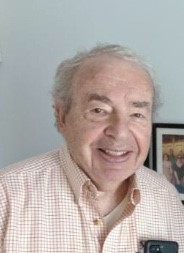In Memoriam: Samuel Z. Burstein
The entire NYU community mourns the passing of alum and faculty member Samuel Z. Burstein on July 24, 2020.

Born and raised in Brooklyn, NY, he earned his bachelor’s (1957), master’s (1958), and doctoral (1962) degrees in Mechanical Engineering from the Polytechnic Institute of Brooklyn, now New York University’s Tandon School of Engineering. From 1962 to 1988, he was an associate professor of mathematics at NYU Courant. Courant, described in A Beautiful Mind, Sylvia Nasar’s biography of mathematician John Nash, as “the national capital of applied mathematical analysis,” was “already rivaling more established mathematical centers like Princeton and Cambridge” in the early 1960s when he started there. In 1958, Nash wrote that “'the open problems in the area of non-linear partial differential equations are very relevant to applied mathematics and science as a whole, perhaps more so than the open problems in any other area of mathematics, and this field seems poised for rapid development. It seems clear, however, that fresh methods must be employed.” Professor Burstein’s 1964 paper "Numerical methods in multidimensional shocked flow," published in the American Institute of Aeronautics and Astronautics Journal, presented at the AIAA aerospace sciences meeting, and sponsored by the Atomic Energy Commission Computing and Applied Mathematics Center at Courant, provided exactly the kind of fresh methods Nash had called for.
Professor Burstein’s work on the mathematics of shockwaves in supersonic flow led to research for the Atomic Energy Commission at Lawrence Livermore National Laboratory. He continued to publish papers (many of them classified), lectured internationally, and co-authored the textbook Calculus with Applications and Computing (1976), which was translated into six languages. Over time, he became increasingly involved in the burgeoning field of applied computing. In 1988, he moved full-time to Hilliard Farber & Co., an interdealer brokerage firm. There, he played an instrumental role in the development of computer systems that served as infrastructure for the rapidly growing bond markets. After retiring in 2002, he continued to consult on multiple systems-related projects.
Among his other interests were high-fidelity audio equipment and recordings; building museum-quality models of full-rigged, historic sailing ships; playing tennis; painting; gardening; and discussing books. In his 70s, he learned to play the cello.
A memorial to celebrate his life will be planned post-COVID.
Our deepest condolences go to his wife of 37 years, Susan, as well to the rest of his large and devoted family. They generously ask that anyone wishing to honor him consider making a donation to the Tandon School of Engineering Emergency Student Relief Fund.




